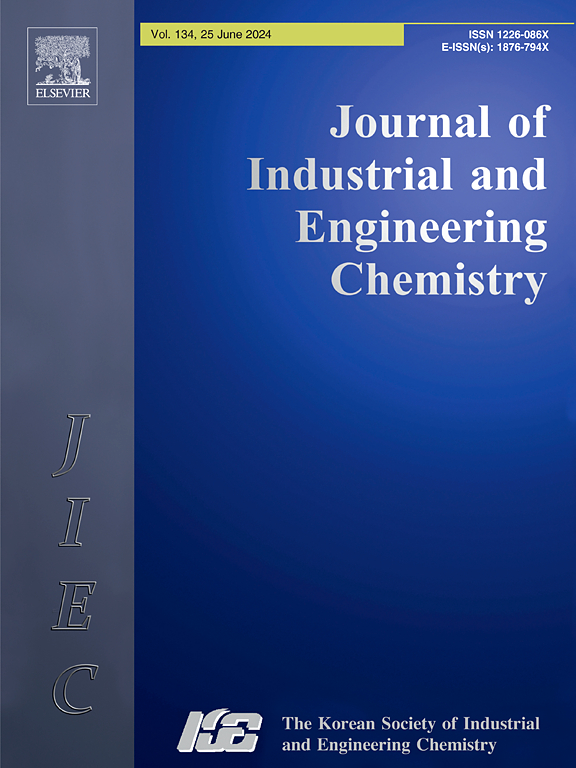越南各种农业废物的生物炭:热解温度对废物管理潜力特性的影响
IF 5.9
3区 工程技术
Q1 CHEMISTRY, MULTIDISCIPLINARY
Journal of Industrial and Engineering Chemistry
Pub Date : 2024-12-06
DOI:10.1016/j.jiec.2024.12.001
引用次数: 0
摘要
越南蓬勃发展的农业部门每年产生大量的农业废物,其中大部分仍未得到充分利用或管理。这带来了环境和经济挑战,包括温室气体排放、土壤和水污染。研究了越南常见的农业副产品——稻壳(RHB)、椰子壳(CCB)、榴莲壳(DRB)、菠萝蜜壳(JFB)和咖啡壳(CFB)——在不同热解温度下制备生物炭的特性。利用扫描电镜(SEM)、能谱(EDS)、BET表面积计算和zeta电位测量等先进的分析技术,对生物炭的理化性质进行了表征。结果表明,该生物炭具有明显的多孔结构、高碳含量(~ 99%)、高达514.3 m2/g的表面积、负表面电荷和高阳离子交换容量(CEC),且在较高的热解温度下性能有所改善。此外,重金属污染物和多环芳烃(PAHs)被检测到可忽略或无法检测到的水平,表明生物炭是环境安全的。这些发现突出了越南农业废弃物中的生物炭作为可持续土壤改良剂和污染物吸附剂的潜力,为农业废弃物管理提供了有效的解决方案,同时支持环境保护。本文章由计算机程序翻译,如有差异,请以英文原文为准。

Biochars from various agro-wastes in Vietnam: Insight into the influence of pyrolysis temperatures on characteristics for potential of waste management
Vietnam’s thriving agricultural sector generates significant quantities of agro-waste annually, much of which remains underutilized or unmanaged. This creates environmental and economic challenges, including greenhouse gas emissions and soil and water contamination. This study explores the properties of biochars produced from common Vietnamese agricultural by-products—rice husk (RHB), coconut shell (CCB), durian shell (DRB), jackfruit shell (JFB), and coffee husk (CFB)—under various pyrolysis temperatures. Using advanced analytical techniques such as scanning electron microscopy (SEM), energy dispersive spectroscopy (EDS), BET surface area calculations, and zeta potential measurements, we characterized the biochars’ physical and chemical attributes. The results showed that the biochars possess distinct porous structures, high carbon content (∼99 %), substantial surface areas up to 514.3 m2/g, negative surface charges, and high cation exchange capacity (CEC), with improved properties observed at higher pyrolysis temperatures. Additionally, heavy metal contaminants and polycyclic aromatic hydrocarbons (PAHs) were detected at negligible or undetectable levels, indicating the biochars are environmentally safe. These findings highlight the potential of biochar from Vietnam’s agro-waste as a sustainable soil amendment and contaminant adsorbent, offering an effective solution to agro-waste management while supporting environmental protection.
求助全文
通过发布文献求助,成功后即可免费获取论文全文。
去求助
来源期刊
CiteScore
10.40
自引率
6.60%
发文量
639
审稿时长
29 days
期刊介绍:
Journal of Industrial and Engineering Chemistry is published monthly in English by the Korean Society of Industrial and Engineering Chemistry. JIEC brings together multidisciplinary interests in one journal and is to disseminate information on all aspects of research and development in industrial and engineering chemistry. Contributions in the form of research articles, short communications, notes and reviews are considered for publication. The editors welcome original contributions that have not been and are not to be published elsewhere. Instruction to authors and a manuscript submissions form are printed at the end of each issue. Bulk reprints of individual articles can be ordered. This publication is partially supported by Korea Research Foundation and the Korean Federation of Science and Technology Societies.

 求助内容:
求助内容: 应助结果提醒方式:
应助结果提醒方式:


